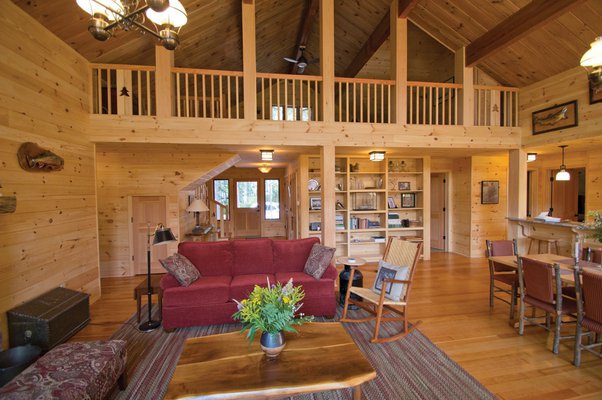Today’s knotty pine paneling is not the thin sheets of 4’x8’ composite material used from the 1960s through the 1980s. It is real wood that comes in an assortment of widths of 4”, 5”, 6”, and 8”. It’s a beautiful and sustainable product that is gaining popularity in many styles of homes and cabins.
Knotty pine should not be painted but should be stained with high-quality materials for beauty, toughness, and durability. Too many people make the mistake of painting knotty pine paneling and later regretting doing it.
What Is Knotty Pine Paneling?
The type of knotty pine paneling homeowners prefer today is real wood that is ¾” thick in widths of 4”, 5”, 6”, and 8” and lengths up to 8’. It is further characterized by its:
- Tongue and groove design
- End-matching feature
- Kiln-dried to perfection
- Hand-inspected boards
- Strength and stability
- Virtual no-waste design
- Ease of installing
This type of pine paneling saves up to 20% in installation time and up to 20% in material waste. These savings are achieved by less measuring and sawing to make ends splice on wall framing. The joints are so strong they fit together anywhere between the wall framing studs.
Knotty pine paneling is a truly sustainable product because the trees are grown on federally-approved tree farms. When a group of them is harvested, more trees are planted in their place for future generations to use.
Do Not Paint Knotty Pine With Oil-Based or Water-Based Paints
Oil-based paints applied to knotty pine paneling can start to peel and flake over time. Oil-based paints keep your paneling from “breathing” and should not be used in place of stains. It also can cause the knots to “bleed” and run on white painted wood that looks bad.
Painting knotty pine paneling can be difficult because the knots and the wood’s texture can be hard to cover with paint. Using water-based or acrylic paints produces the same negative effects as oil-based paints. Although it’s a popular idea to paint knotty pine wood white, it can produce some problems. The best finishing results are obtained by using quality stain such as whitewash stain.
Stain Knotty Pine Paneling Instead Of Painting
Stain your knotty pine paneling instead of painting it for the best overall results. It is typically available in translucent or semi-transparent options. Here are some practical reasons why you should stain your wood paneling:
- Dries quicker than paint
- Easier to apply and often only needs one coat
- Easier to clean and care for
- Economical compared to most paints.
- Preserves wood’s natural beauty better
- Protects wood by sealing off the pores and prevents water absorption
- Quality stains penetrate the wood grain to prevent wood rot
- Protects wood from harmful UV rays by adding a layer of protection that minimizes any discoloration
- Takes impact better than painted surfaces
- Versatile because it applies easier on rough, smooth, uneven, or knotty surfaces.
Choices Of Popular Pine Color Stains And Their Application
Wood stain is available in a myriad of attractive colors and hues for walls and ceilings. High-quality Sherwin Williams or Minwax stain offers these favorite color options:
Bronze Walnut Chestnut Classic Gray Early American
Fruitwood Washington Cherry
Wheat White Ash
Whitewash
Assuming you have already installed the paneling on the walls or ceilings, you should do the following when staining your paneling to ensure a smooth finish:
Cleaning - Clean the walls with a cloth or vacuum with a brush attachment. Next, apply a pre-stain conditioner to prevent blotching.
Applying - Apply the stain with a stain brush or roller explicitly designed for finishing knotty pine paneling. These brushes have unique bristles that help to achieve a smooth finish.
Drying - When dry, apply a second coat if necessary.
Caring For Your Stained Knotty Pine Paneling
The two most common ways to care for stained knotty pine paneling on walls or ceilings are removing dust and grime buildup. There’s a bit more cleaning in homes that have active small children and pets. We recommend taking the following steps to easily clean your real wood paneling:
Dust Build-Up: Use a static dusting brush or a vacuum cleaner with a dusting brush attachment. Don’t use the hose without an attachment because the plastic could scratch the walls. Be sure to get the dust out of every joint and crevice for healthy and clean house walls.
Grime Build-Up: Use a damp microfiber cloth to clean grime or minor scuff marks. If the grime is stubborn or sticky, then dip the cloth into a mixture of water and mild detergent and gently rub it off. Here is another way to clean your finished walls.
Now that you are more aware of the advantages of staining knotty pine paneling over painting it, did you know it is also available in a pre-finished condition? This simplifies your installation job as well as speeds it up.


No comments yet